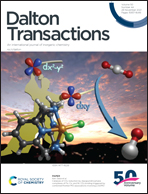The aqueous interaction of neodymium with two omni existent biomoieties – a mechanistic understanding by experimental and theoretical studies†
Abstract
Neodymium (Nd), a technologically important metal ion, has emerged as a major contaminant in aquatic systems in recent years owing to its surge in electrical and electronic applications as a permanent magnet. The chelating molecules present in hydro- and biospheres could substantially enhance its absorption and lead to transportation and migration of Nd from the source. The mechanistic understanding of the Nd interaction with naturally relevant biomoieties present in flora and fauna is of primitive importance to estimate the toxicological effects of the metal ion. The present studies aimed at understanding the aquatic interaction of Nd with two biomoieties namely pyrazine-2-carboxylic acid (P2C) and pyrazine-2,3-dicarboxylic acid (P23C) by multiple experimental determinations and theoretical estimations. Potentiometry and spectrophotometry were employed to determine the aquatic speciation and thermodynamic stability of the complexes. Both techniques supported the formation of MLi (i = 1–4) complexes by Nd(III) with P2C and MLi (i = 1–3) complexes with P23C. The Nd–P23C complexes are more stable than the Nd–P2C complexes for ML formation, while the opposite trend is observed for the ML2 and ML3 complexes. Titration calorimetry was used to determine the enthalpies of complexation which was found to be exothermic and majorly favored by entropy contributions. The formation of the Nd(III)–P2C complexes is more exothermic than that of the respective Nd(III)–P23C complexes. Density functional theory was employed for the geometry optimization of the predicted complexes and for the estimation of the bond distances and partial charges on the coordinating atoms in the optimized geometries. Experimental insights provide crucial inputs at the macro (thermodynamic) level and theoretical calculations help in understanding the complexation process at the molecular level.



 Please wait while we load your content...
Please wait while we load your content...